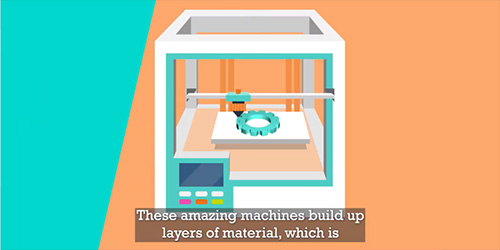Rethinking 3D printing: Towards connected, responsive, accessible manufacturing
3D printing has become a familiar concept, with homes, universities, workplaces, and industry adopting the technology in droves. A University of Bristol research project will explore how this kind of ‘additive’ manufacturing could rise to the next level, connecting individual devices to form a dynamic and self-regulating UK-wide printing network.
Additive Manufacturing (AM) builds up layers of material to form a three-dimensional ‘print’. Currently, manufacturing devices – whether this be the printer you have at home or those at a large industrial facility – tend to work in isolation, making it difficult to distribute work and react swiftly to societal challenges.

The importance of connectivity has become clear during the COVID-19 pandemic, when the ability to identify and communicate with available devices to rapidly print Personal Protective Equipment would have been hugely valuable.
A UK-wide network
Over the next year, the ‘Brokering Additive Manufacturing’ (BAM) project – based at the University of Bristol’s Design and Manufacturing Futures Laboratory (DMF Lab) – will explore the best way to connect and control machines across the UK, by characterising, modelling and demonstrating how a nationwide ‘AM network’ could work.
The project will create both real-world and virtual demonstrations of the network; anyone interested in the project will be able to access and engage with the research online, at the Lab, or at various industry events (when and where possible), and play with different scenarios to see how the network could suit their device or facility.
Turning printers into brokers
Excitingly, the proposed network will not only connect devices but also give each the chance to act as its own broker, allowing it to self-regulate and bid for work. This will be done via an agent-based approach, with devices allowed to act as their own agents within a system bound by wider rules of engagement (to manage complexity and optimise for – for instance – cost or sustainability).
“We aim to show how UK manufacturing can become more connected and responsive – and, in collaboration with the University of Bristol’s Business School, we’ll also be looking into the business models and policy that would underpin such a network, to ensure it embodies the principles of responsible innovation. It’ll be forward-looking, equitable and accessible to all,” says project Principal Investigator James Gopsill.
“The network’s underlying architecture will allow anyone with an AM machine to plug in to the system and participate independently to help meet manufacturing demand in the UK.”
Your chance to get involved
James is one of nine project staff based at the DMF Lab, where researchers explore innovative tools and technologies to enable the design, manufacture, operation and disposal of next-generation products. The team is completed by four Co-Investigators (Ben Hicks, Chris Snider, Jennifer Johns and Mark Goudswaard), and three Research Associates – Kautsar Ramli, Martins Obi, and Lorenzo Guinta.
Expand your knowledge
The project is supported by the Centre for Modelling and Simulation, Renishaw, GTMA Trade Association, Reshoring UK, Business West, AT 3D Squared, Create Education, several individual industry experts and funded by the Engineering and Physical Sciences Research Council (EPSRC – EP/V0113X/1). Crucially, its outputs will be open to anyone with an additive printing device, with anyone interested encouraged and welcome to take part and, in time, join the system.
For more information and updates on the network as it takes shape, visit the BAM project page on the DMF lab website or contact the PI at james.gopsill@bristol.ac.uk.


